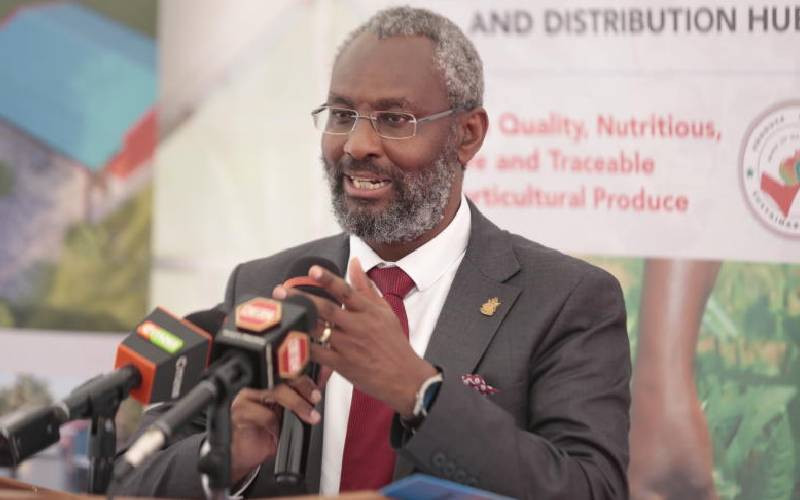Built with the concept of fine crystals stacked upon each other, The Prism is one of the latest architectural marvels leading Nairobi’s race to the skies.
The 133-metre high building towers above the drab Community area in Upper Hill, which is known for tired government buildings. Its shiny jewel form is easily visible many miles away from where it stands on Third Ngong Avenue.
But if buildings had emotions, The Prism would weep of loneliness. Beneath the shiny veneer of its 28 floors meant for offices are zero tenants.
“Located just where any growing company should be,” is the phrase its marketers use to sell it. However, almost two years after completion, they are yet to find a single occupant.
The only activity is the buzz of a handful of government-contracted workers rehabilitating the public road at the building’s entrance.
The 34-storey building by Kings Developers was launched in 2018 in a colourful ceremony presided over by President Uhuru Kenyatta. However, its sad tale of emptiness has now become a harsh reality for majority of developers and investors in the march to heaven.
Dozens of office buildings in the ‘well-connected’ Upper Hill business district of Nairobi are struggling to find occupants. This is on the back of an oversupply of commercial space plaguing the country.
One recent market report projected that the oversupply of office space would hit 5.8 million square metres this year, as more mega-structures come up.
As occupancy rates for offices fall, rental yields have also stagnated over the last few years, and things will only get worse for landlords until the market oversupply can correct itself.
Asked why most buildings are vacant, land economists and real estate experts point to a combination of factors only made worse by a “bad” economy.
Paul Maurice Syagga, who teaches land economics at the University of Nairobi’s Department for Real Estate and Construction Management, says developers started mega constructions on the premise that Kenya’s economy would continue to expand, and thus would require office space.
This was especially against the backdrop of the Grand Coalition Government that kick-started huge infrastructural projects.
In addition, between 2013 and 2018, the country experienced a construction boon from both the State and the private sector, with gross domestic product more than doubling from Sh4.7 trillion in 2013 to Sh8.9 trillion in 2018.
Prof Syagga, however, says an expanded economy is yet to be realised and the money never trickled down. This means that those who need offices to provide services have no money to rent them, while the government and companies are cutting costs.
“There is no demand now because of the low economy. When the buildings were being built, there were projections that the economy would expand based on past information,” he said.
Stay informed. Subscribe to our newsletter
Property development, he said, has a long “gestation” period from the time an idea is conceived up to the time money is found to start construction.
He added that in Kenya the gestation had matured all at once as witnessed with the mall frenzy, with many buildings coming up at the same time.
“They have all come up at a time when the economy is terrible.”
But it is not only Upper Hill that is drowning in office oversupply. Scores of new buildings with thousands of floor space have come up since last year in Nairobi and across the country.
The last few years have seen most organisations shift from the CBD, creating ‘extensions’ full of skyscrapers in areas such as Westlands, Kilimani, Parklands and Riverside.
Described as “secondary business districts” in market lingo, the new zones were previously low-density residential areas, but are now full of offices that are preferred by NGOs and multinational companies.
The rise of Upper Hill, which boasts of Kenya’s tallest building – the 200 metres tall Britam Towers - is, however, at a crossroads.
A spot check by The Standard has only confirmed the oversupply. “To Let” banners colour the area. Only one building has a “fully rented” banner outside.
In a few years, the area might host Africa’s tallest building, The Pinnacle that will stand at 1,000 feet. The 70-storey development will have 11 floors offering Grade “A” commercial offices covering 75,000 square feet and also luxury apartments on over 40 floors.
However, The Pinnacle’s construction appears to have stalled.
Commercial office buildings are classified in three grades – A, B and C. This is according to age, aesthetics, amenities or infrastructure. Most of them also have retail spaces such as cafes and banks to serve walk-in clients.
Grade A, such as Britam Towers and The Prism, is the highest quality and the top choice for most multinationals. The buildings might have been constructed during the last five years and feature modernist architecture and the latest services.
Grade B buildings are aged about 15 years but are well maintained while Grade C are the lowest quality, might be more than 15-years-old, feature ‘old’ architecture and may not have on-site parking.
Statistics by property manager Knight Frank show that absorption of Grade A and B office space in Nairobi fell by eight per cent in the first half of 2019, compared to the previous year.
“The decline in office uptake and stagnation of rental prices is mainly attributed to the continued oversupply of commercial space in some locations and the current economic slowdown,” said Knight Frank.
Britam Towers is yet to be fully occupied. However, Britam Group Managing Director Benson Wairegi has said that they are “not looking for just anyone with some cash to become a tenant.”
“We take a long-term view of our investments. We know international corporates are looking for such kind of offices. We are not afraid to wait for the right clientele,” he said in a previous interview with The Standard.
Other buildings struggling to find tenants in Upper Hill include Kasneb Towers.
To lure tenants, real estate agents, property developers and landlords have to be smart and innovative.
Some landlords are finding it imperative to offer rental concessions. These include longer fit-out periods or giving discounts so as to retain existing tenants and attract new ones, says Knight Frank.
Developers are also getting good returns through concepts such as serviced offices – fully furnished spaces. These might be located in areas that have low supply but offer high returns such as Gigiri and Karen.
Knight Frank says the serviced office sector has grown rapidly over the last few years due to shared workspace entrants, demand from SMEs, maturing start-ups and multinational firms.
“Serviced offices allow organisations to have flexible lease agreements and office space, lower operating costs and the opportunity of being located in a prime address,” said the firm.
A 2019 market research by multinational real estate firm Broll Property shows that Westlands leads the market office supply market with about 623,000 square metres of floor space, with 75 per cent of it classified A.
Upper Hill and Kilimani have the next largest share of A-grade and B-grade buildings at 478,000 and 324,000 square metres respectively.
The CBD, followed by Kilimani, Karen, Westlands and Parklands top the list of B-grade space with high occupancy rates of over 80 per cent. Upper Hill has occupancy of 67 per cent.
The CBD has a “gross lettable area” of 151,781, according to Broll. And the recent wave of exits by organisations has led to the growth of stalls in place of offices.
Historically, most offices were domiciled in the CBD, but the recent past has seen a shift to areas such as Parklands, Kilimani and Riverside, partly attributed to congestion and parking challenges.
However, the CBD is still preferred by most local organisations and government.
“The extended business districts have since become preferred addresses for blue-chip tenants as they provide quality office stock, are centrally located, offer easy accessibility and proximity to other socio-economic activities,” said Broll Property.
 The Standard Group Plc is a
multi-media organization with investments in media platforms spanning newspaper
print operations, television, radio broadcasting, digital and online services. The
Standard Group is recognized as a leading multi-media house in Kenya with a key
influence in matters of national and international interest.
The Standard Group Plc is a
multi-media organization with investments in media platforms spanning newspaper
print operations, television, radio broadcasting, digital and online services. The
Standard Group is recognized as a leading multi-media house in Kenya with a key
influence in matters of national and international interest.
 The Standard Group Plc is a
multi-media organization with investments in media platforms spanning newspaper
print operations, television, radio broadcasting, digital and online services. The
Standard Group is recognized as a leading multi-media house in Kenya with a key
influence in matters of national and international interest.
The Standard Group Plc is a
multi-media organization with investments in media platforms spanning newspaper
print operations, television, radio broadcasting, digital and online services. The
Standard Group is recognized as a leading multi-media house in Kenya with a key
influence in matters of national and international interest.









